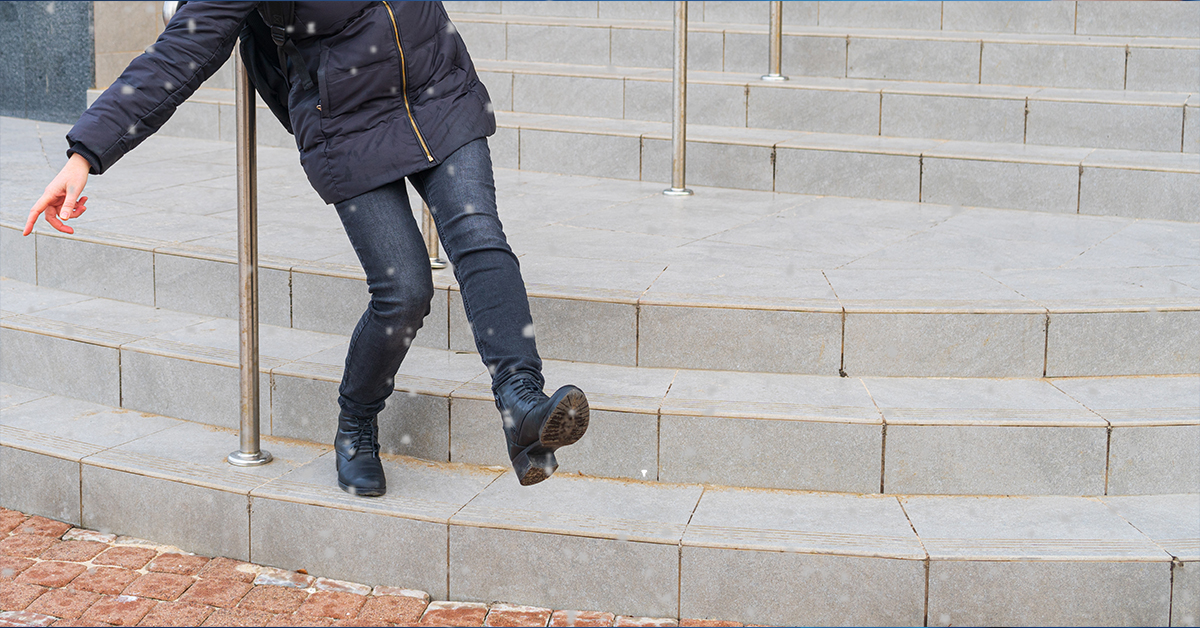Winter Slips, Trips, and Falls

How Municipalities Can Cut Risk Before It Hits the Ground
When the temperature drops, the risk of slips, trips, and falls skyrocket, especially on municipal sidewalks, pathways, parking lots, and facility entrances. For local governments, these incidents aren’t just safety issues; they’re a source of costly claims, strained staff resources, and public trust concerns.
Digital tools like inspection and work order software can’t control the weather, but they can help municipalities prove due diligence, respond faster, and prevent many incidents before they happen.
Why winter falls are a municipal problem
Across Canada, falls are the leading cause of injury-related hospitalizations. According to the Canadian Institute for Health Information (CIHI), falls account for about 40% of all injury-related hospital admissions nationwide.
Slips and falls on ice and snow are a major contributor. One analysis of Canadian data notes that:
-
Snow and ice are among the most common causes of slip-and-fall injuries, alongside spilled liquids and uneven surfaces.
-
In 2020–2021, there were over 160,000 fall-related hospitalizations in Canada, with thousands specifically tied to icy conditions.
In the workplace, the picture is similar. In North America, slips, trips, and falls represent roughly 20% of all reported workplace injuries, and winter weather is a key driver of that spike.
For municipalities that maintain:
-
Kilometers of sidewalks and trails
-
Parking lots at arenas, pools, and community centers
-
Transit stops and park-and-ride lots
-
Stairs, ramps, and building entrances
…winter slip-and-fall risk is everywhere.
The liability landscape: what courts expect of municipalities
Municipalities have a legal duty to keep roads and sidewalks in a state of reasonable repair. In Ontario, for example, those duties are outlined in the Municipal Act, 2001, and similar standards exist in other provinces and states. Courts look at whether a municipality took “reasonable steps” to control snow and ice based on weather conditions, traffic levels, and available resources.
Recent case law around winter slip-and-fall claims highlights several important realities for municipalities:
-
Sidewalks are usually municipal responsibility. Even when bylaws require adjacent property owners to clear snow, courts in B.C. have held that residential owners generally do not owe a duty of care to pedestrians on municipal sidewalks.
-
Policies matter, but only if you follow them. Many cities have documented winter maintenance standards. If inspections, plowing, sanding, or salting don’t happen as scheduled, it becomes harder to defend a claim.
-
Documentation is critical. When a claim arises, municipalities are often required to respond quickly and provide records of inspections, work orders, and completed maintenance tasks on the specific route or location at the time of the incident.
In short: municipalities aren’t expected to prevent every fall, but they are expected to act reasonably, consistently, and to be able to prove it.
Where winter risk shows up in municipal operations
Here are some of the highest-risk areas CityReporter clients often talk about:
-
Sidewalks and pedestrian routes
-
High foot traffic near schools, downtown, transit hubs, and seniors’ complexes.
-
Black ice on shaded sections or slopes.
-
-
Parking lots and facility entrances
-
Rinks, arenas, pools, community centers, and libraries generate steady traffic.
-
Melt-and-freeze cycles near doorways and curb ramps.
-
-
Parks and trails used year-round
-
Multi-use paths that double as commuter routes.
-
Stairs, footbridges, and boardwalks with poor drainage.
-
-
Transit stops and park-and-ride lots
-
Bus stops that remain busy even during storms.
-
Areas where snow storage reduces visibility or narrows walking space.
-
-
Municipal buildings and yards (staff and visitors)
-
Public works yards, fire halls, and administrative buildings.
-
Loading areas and external stairs used by staff in all weather.
-
Common gaps that lead to slips, trips, and falls
Even well-run municipalities struggle with winter risk when:
-
Inspections are paper-based or ad hoc. Staff may be doing the work, but their notes are scattered in binders, emails, or personal notebooks.
-
Crews work offline without reliable records. When connectivity drops, so does documentation—unless mobile tools work offline.
-
There’s no clear history of what was done, when, and by whom. Defending a claim months later becomes almost impossible without the appropriate documentation.
-
Citizen reports aren’t captured in one place. Complaints about icy conditions might sit in someone’s email or voicemail instead of triggering a work order.
-
No easy way to prioritize “hot spots.” Locations near seniors’ residences, schools, or hospitals may not be flagged for more frequent checks.
The result is higher risk and more stress: every storm means hoping you haven’t missed something.
How digital inspections reduce winter slip-and-fall risk
Municipalities are increasingly turning to inspection and asset tracking tools (like CityReporter) to turn winter from reactive crisis mode into a more controlled, documented process.
Here’s how digital workflows help:
1. Standardized winter inspection checklists
Create specific custom inspection forms for:
-
Sidewalk routes and zones
-
Facility entrances and parking lots
-
Trails and parks maintained in winter
-
Transit stops and park-and-ride areas
Each checklist can prompt staff to confirm conditions like:
-
Packed snow or ice present
-
Sanding/salting completed
-
Drains and catch basins clear
-
Snowbanks impacting visibility or narrowing paths
-
Handrails and stairs clear and secure
This reduces variation between staff and creates a consistent standard of care with tailored checklists for your specific municipal infrastructure.
2. Real-time and offline field records
With a mobile inspection app that works offline, crews can:
-
Complete inspections on a phone or tablet in the field
-
Automatically time- and date-stamp each inspection with a signature
-
Capture photos of conditions before and after treatment
-
Sync data when they’re back in coverage
If a claim is filed weeks or months later, your team can quickly pull the inspection history for that exact location and date.
3. Automatic work orders from issues or complaints
When an inspector or citizen reports an icy condition, a work order can be:
-
Generated automatically from the inspection or citizen portal submission
-
Assigned to the right crew based on route, department, or facility
-
Tracked through to completion, with time, materials, and photos recorded
This closes the loop, no more lost sticky notes or missed voicemails.
4. Better visibility for supervisors and CAOs
Supervisors and managers can see:
-
Which routes and facilities have been inspected today
-
Open, in-progress, and completed work orders
-
Trends in complaints or near-misses by location
This allows municipal leaders to re-allocate crews during ongoing storms and to communicate confidently with council and the public.
Turning data into risk reduction (and stronger claims defense)
Digital inspection data doesn’t just help you respond in the moment, it helps you improve over time.
With a system like CityReporter, municipalities can:
-
Identify hot spots
Use reports to flag locations with multiple complaints, near-miss reports, or incidents over the last few winters. Focus extra monitoring or infrastructure improvements there. -
Review and refine service levels
Compare inspection frequency and timing against incident history and weather records. Adjust routes and schedules to match real risk rather than tradition. -
Support budget requests with evidence
Show council how winter slips, trips, and falls correlate with staffing levels, equipment, or materials. It’s easier to justify an extra sidewalk crew or better de-icing materials with data, not just anecdotes. -
Defend claims more effectively
When you can provide time-stamped inspections, photos, and work orders for the date and location in question, you demonstrate that the municipality took “reasonable steps” consistent with its policies—often a crucial factor in court.
Practical steps municipalities can take before the snow flies
If you’re looking to strengthen your winter slip-and-fall prevention strategy this year, here are some actionable steps:
-
Review your winter maintenance policies and bylaws.
Ensure they are realistic, clearly written, and aligned with available resources and legal standards. -
Map your highest-risk locations.
Use past incident data (if available), staff input, and common-sense risk factors (seniors’ areas, schools, slopes, shaded sidewalks). -
Digitize your winter inspection routines.
Move from paper to mobile inspections for sidewalks, parking lots, facilities, and public spaces, especially those maintained in winter. -
Connect inspections to work orders.
Make sure every identified hazard can quickly become a tracked work order, not just a note in someone’s pocket. -
Provide an easy reporting channel for citizens.
A simple web or mobile portal allows residents to report icy spots, with submissions flowing directly into your system rather than getting lost in email chains. -
Train staff and document everything.
Train crews on both their safety responsibilities and how to use the digital tools. Good documentation helps protect them as well as the municipality.
Safer winters, stronger municipalities
Winter slips, trips, and falls aren’t going away. But municipalities don’t have to accept them as an inevitable cost of doing business.
By combining:
-
Clear policies and service levels
-
Proactive inspections
-
Fast, trackable response
-
Solid documentation for every storm
…local governments can reduce injuries, control liability, and show residents that safety really is a priority.
If your municipality is still relying on paper forms, spreadsheets, or memory to manage winter risk, it may be time to explore how CityReporter’s digital inspection and asset management tools can support safer, more defensible winters for your staff, your residents, and your budget.


